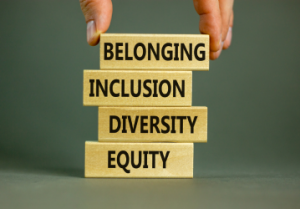Embracing Diversity: Understanding Personality
 Celebrating Diversity
Celebrating Diversity
In a world where diversity is celebrated, it is essential to understand and appreciate the various personality traits that make individuals unique. Four common terms used to describe personality types are introvert, extrovert, ambivert, and shy. While these labels are often used interchangeably, they each represent distinct characteristics. In this blog, we will explore the differences between introverts, extroverts, ambiverts, and shy individuals. Furthermore, we will provide valuable hints and tips to foster inclusivity and promote a more understanding environment for everyone.
Have you ever worked in a team where the boss says, “Well you just need to be more…..”. I am sure most of us can think of an example. Is your workplace more biased toward extroverts and ambiverts? So many people confuse introverts and shy for example. Do you really understand the different terms? How can you make your team more inclusive and benefit everyone? How can you embrace diversity?
Introverts:
Introverts are individuals who draw energy from within themselves. They tend to feel recharged through solitary activities and introspection. Introverts may prefer smaller, intimate gatherings and often engage in deep, meaningful conversations rather than small talk. They are generally more reflective, thoughtful, and reserved. While they may appear quiet or reserved, introverts possess valuable insights and strengths that are worth appreciating.
Tips for inclusivity:
a) Create quiet spaces: Recognize that introverts thrive in environments where they can find solace and recharge. Providing quiet areas or designated spaces for introspection can greatly benefit introverted individuals.
b) Encourage written communication: Introverts often excel in expressing themselves through writing. Encouraging written communication channels such as emails or online forums can help them contribute and feel more comfortable expressing their thoughts.
Extroverts:
Extroverts, on the other hand, are energized by social interactions and external stimuli. They thrive in lively environments and gain energy from being around others. Extroverts typically enjoy engaging in group activities, initiating conversations, and networking. Their outgoing nature often helps them connect with people easily and fosters a sense of enthusiasm.
Tips for inclusivity: a) Allow for group interactions: Extroverts feel most comfortable when interacting with others. Providing opportunities for group discussions or team activities can help them contribute and showcase their strengths. b) Be an active listener: Show genuine interest when extroverts share their experiences and stories. Engage in conversations and encourage their participation in group settings, making them feel valued and heard.
Ambiverts:
Ambiverts fall in the middle of the introvert-extrovert spectrum and possess a balance of traits from both ends. They are comfortable in social situations but also appreciate alone time for introspection. Ambiverts may exhibit extroverted tendencies in certain scenarios and introverted tendencies in others. Their flexibility allows them to adapt to a variety of social dynamics.
Tips for inclusivity:
a) Offer options: Recognize that ambiverts may have varying preferences depending on the situation. Providing them with choices, such as participating in group activities or opting for individual tasks, allows them to navigate their energy levels more effectively.
b) Practice active observation: Pay attention to cues that indicate whether an ambivert is seeking solitude or social interaction. By understanding their subtle signals, you can create an environment that respects their needs and preferences.
Shy Individuals:
I always thought I was an introvert until I started learning about psychometric profiling. I learned that I am actually strongly extroverted in many circumstances, but actually, I am also quite shy.
Shyness is not synonymous with introversion, extroversion, or ambiversion. Shy individuals experience social anxiety and discomfort in social interactions, often leading to hesitation or withdrawal. Shyness is a personality  trait that can affect people across the introvert-extrovert spectrum. It is important to remember that shyness is not a flaw but rather a personal characteristic.
trait that can affect people across the introvert-extrovert spectrum. It is important to remember that shyness is not a flaw but rather a personal characteristic.
Tips for inclusivity:
a) Foster a supportive environment: Encourage a nurturing and understanding atmosphere where shy individuals feel safe to express themselves at their own pace. Avoid putting them on the spot or pressuring them to participate in situations that cause significant distress.
b) Small group interactions: Provide opportunities
The key to any environment is to embrace diversity and be as inclusive as possible. Understanding these different personality traits is key to improving relationships and communication. Giving everyone space and encouraging them to be themselves increases creativity, which in turn increases ideas. If people feel included then they want to stay working where they are. At a time when professional talent is scarce, think about how you can include everyone in your team.



